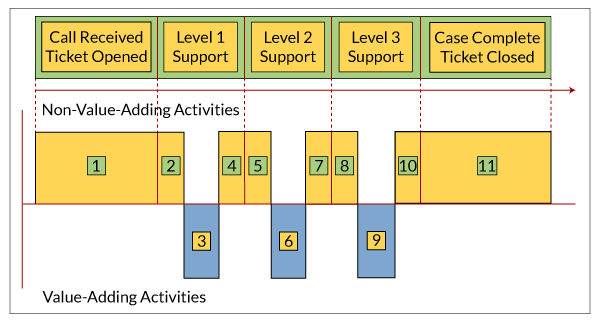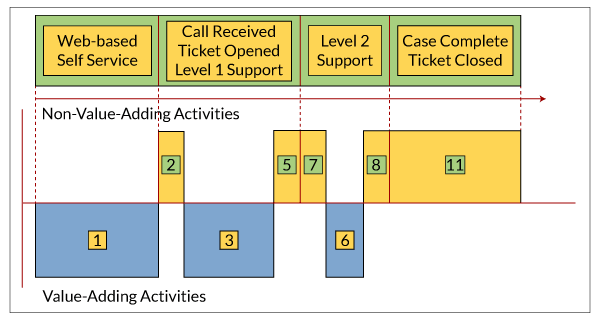
Help desks often face a barrage of complaints when voice of the customer (VOC) data is collected. These typically include:
- “I had to describe the problem to more than one person before it was solved.”
- “I had to describe the problem to more than one person, and each time I was asked to do the same set of diagnostic steps all over again.”
- “Sometimes I received rapid service and sometimes it took way too long. Some of the support people I spoke with were able to find the problem quickly and others were not.”
- “The problem was pretty simple. I wish there was a website where I could first search for a solution before calling the help desk for support.”
- “Before I could speak to a human being, I had to go through a long and tedious [interactive voice response] menu.”
Lean Six Sigma can help overcome these issues through the use of an efficient, effective process to review and improve help desk functions. The Lean technique focuses on process cycle efficiency (PCE) as a measure of process execution speed, the first step in understanding how a function works, according to Michael L. George, author of the book Lean Six Sigma.
Process cycle efficiency = value-added time / total elapsed time
A Lean process produces a PCE of 25 percent or more. Most service processes like help desks are not Lean with 20 percent of the activities contributing 80 percent of the waste in the process, according to author George. One of the main goals of Lean is to increase process velocity. Improving PCE helps achieve that goal by eliminating non-value-added activities from the process. Lean methods such as value stream mapping also provide a systematic way to identify and eliminate waste.
Identifying relevant qualitative and quantitative metrics for a specific function play a key role in understanding variation within that function. Measuring variation before and after implementation of a Lean process allows the business to identify random variations in critical-to-quality (CTQ) measures and focus a root cause analysis on only those instances where the function routinely impacts CTQs. Measurement of key CTQs and statistical process controls helps ensure that implementing a Lean help desk will create a better service experience for the client.
Value stream analysis can uncover activities that add waste to a typical help desk organization. Then that analysis can naturally lead to the implementation of a Lean Six Sigma help desk design. That process and descriptions of what is necessary at the organizational level to ensure that the Lean help desk succeeds are explored here.
Typical Help Desk Design
Figure 1 depicts the typical design of most help desks, where a problem or question enters the process stream and is touched from one to three times depending on the skill and knowledge of the support personnel handling the request. While this design has improved over time, the accompanying value stream analysis reflects the continued presence of waste activities within the process flow. A majority of the activities are non-value-added and represent a large portion of the overall process time.

An activity adds value if it directly benefits the customer. Non-value-added activities may help the organization provide a service, however, they do not add benefit to the customer. The objective of Lean Six Sigma is to increase the velocity of the process and the best way to do that is to eliminate as many non-value-added activities as possible, reducing the total elapsed time of the process. In addition, a focus on reducing process time for value-added activities also is important as long as critical-to-quality metrics are not compromised.
Critical-to-Quality Metrics: A number of quantitative and qualitative critical-to-quality metrics are used to monitor help desk processes. Quantitative measures include average resolution time from opening a ticket to closing it, average cycle time for Level 1 support, average cycle time for Level 2 support, etc. For the initial phone call, other measures such as average handle time, average hold time, and number of calls held also are good measures. It is important to measure the variation in these metrics in an effort to maintain a consistent client experience. Qualitative measures are obtained from VOC efforts such as customer satisfaction surveys, which measure overall customer satisfaction with the entire help desk process as well as satisfaction with individual process steps. Using Lean Six Sigma to improve the help desk design requires measuring CTQ metrics before and after improvement efforts are made, ensuring that they reflect an improved process and that they remain in statistical process control.
Lean Help Desk Design
Figure 2 presents a possible Lean help desk implementation addressing a number of issues typically identified when collecting VOC data. This design also helps achieve the goal to improve the velocity of the help desk process. A value stream analysis is depicted, reflecting the implementation of the following improvements to the process:
- Introducing web-based self-service knowledge management and frequently asked questions (FAQs) functionality has the potential to significantly reduce calls to the help desk. Customers first search the support section of the website to see if their question was already answered for another customer. If not, they enter the question and await an answer by email. Over time, the problem knowledge base covers more and more FAQs or commonly seen problems, and calls to the help desk are reduced. Since the knowledge management function is available 24/7, it provides convenience to customers with questions.
- Improving first-call resolution is accomplished by ensuring that the help desk person receiving the call has the skills needed to solve the problem right away. This improvement minimizes total resolution time, increasing customer satisfaction.
Overall, the entire process has fewer steps and also incorporates ideas that increase process velocity.

Organizational Support Requirements
There are a number of organizational requirements that are needed for the successful implementation of a Lean help desk. They include:
- Active promotion of self-service options: Offer encouragement and incentives for customers to try the web-based self-service knowledge base. Promote the site with customers at every opportunity and ensure that it is available when customers log in 24/7.
- Job rotation and multi-skilled workforce: Switching from a help desk where the first responder passes the call to an expert for resolution, to a system where resolution is attempted on the first call, requires a population of agents that have a diverse set of skills. This is likely to involve more extensive training of agents. Some help desks designed for first-call resolution use an approach where agents work as a team on difficult problems, leveraging the skills of more experienced agents.
- Empowered help desk agents: A Lean help desk involves giving more authority to agents to resolve problems. That means a full understanding of the organization and how cutting across functional areas influences these issues.
- Restructured incentives and awards: Incentives and awards in traditional help desks are more tuned toward agents working on problems individually. A Lean help desk should emphasize teamwork, velocity of problem resolution and customer satisfaction more than metrics tailored for the individual agent.
Lean Six Sigma offers a systematic way to analyze a help desk design and identify ways of increasing process velocity through reducing non-value-added activities. Six Sigma provides the tools to measure variation in critical-to-quality metrics and monitor the level of statistical control, helping companies improve help desk processes.